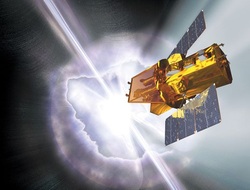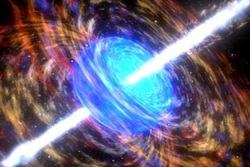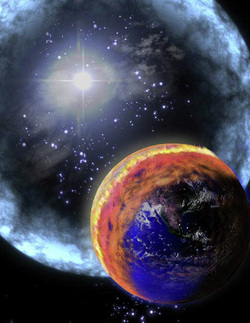Gamma-Ray Bursts: What are they?

Gamma Ray bursts are concentrated beams of radiation that are formed by supernovae. These beams are very bright, up to ten million times the brightness of our sun. However, there still is a chance that these ultra-concentrated beams of radioactivity could destroy our planet. These beams of light and radioactivity are so bright, that even the naked eye could see a Gamma-Ray burst on a cloudy night, and the Gamma-Ray Burst is happening billions of light years away.
In fact, on the 21st June 2010, a Gamma-Ray Burst that signalled the creation of a new black hole, was so bright that it blinded a NASA telescope satellite, even though the Gamma-Ray Burst was from over five billion light years away. The satellite, called Swift, was so overwhelmed that its data processers, designed for Gamma-Ray Bursts, shut itself down for a week. "This thing was so bright it completely saturated the detectors," said Burrows, who is also a professor of astronomy and astrophysics at Penn State University. Swift "wasn’t hurt or anything. But the software on the ground thought something was wrong with the data and threw it out. We didn’t catch what happened for almost a week."
In fact, on the 21st June 2010, a Gamma-Ray Burst that signalled the creation of a new black hole, was so bright that it blinded a NASA telescope satellite, even though the Gamma-Ray Burst was from over five billion light years away. The satellite, called Swift, was so overwhelmed that its data processers, designed for Gamma-Ray Bursts, shut itself down for a week. "This thing was so bright it completely saturated the detectors," said Burrows, who is also a professor of astronomy and astrophysics at Penn State University. Swift "wasn’t hurt or anything. But the software on the ground thought something was wrong with the data and threw it out. We didn’t catch what happened for almost a week."
How does a Gamma-Ray burst occur?

Gamma-Ray bursts occur when a red giant, at the end of its life, runs out of fuel and can no longer support itself. It collapses, crushing it into a black hole(see the page:'Black Holes'). Matter from the star falls towards the black hole at its centre, and before it falls in, some of its energy is focused into powerful jets that pummel out of the north and south poles of the star, making a gamma-ray burst. The rest of the star explodes as a supernova soon afterwards. We used to believe that Gamma-Ray bursts came from stars in our galaxy, because of the intense energy, but they actually travel from distant galaxies. In fact, a Gamma-Ray burst is so powerful that it has the same amount of power as the Sun will ever produce or release in fifty years.
How can Gamma-Ray Bursts destroy our planet?

When a Gamma-Ray Burst hits our planet, it will cause a catastrophe on a global scale. Recent computer models show that if a Gamma-Ray Burst hit our planet, it would severely weaken the ozone layer, allowing the dangerous UV radiation from our Sun to kill us. It will also trigger global cooling because after the Gamma-Ray Bursts strike, a dark, nitrogen-like gas will form and block out the Sun. After that there will be acid rain. So imagine being fried, frozen and then having everything around you turned to nothing. Recent studies show that a catastrophe like that could wipe us out.
According to the National Geographic News, Gamma-Ray Bursts might’ve caused an accident on Earth so disastrous, 70% of all marine life-forms in the Ordovician Period. The simulation also shows that a significant gamma-ray burst is likely to go off within range of Earth every billion years or so, although the stream of radiation would have to be lined up just right to affect our planet.
Currently WR104, a massive star 8,000 light-years away in the constellation Sagittarius, is in position to be a potential threat, according to the studies.“It could happen, but it is so unlikely that it is not worth worrying about,"says Brian Thomas, an astrophysicist at Washburn University in Kansas. Thomas was the leader of the study team who came up with the computer model and the theory that a Gamma-Ray burst caused the extinction of most of the marine life-forms of the Ordovician Period.
However, Bruce Lieberman, a palaeontologist at the University of Kansas, says that worry over a future gamma-ray burst is "not the thing that's keeping me up at night." Instead he appreciates the new work for pointing out that Earth is a vulnerable part of the cosmos. "It gives us a new perspective on things like natural selection and adaptation."
According to the National Geographic News, Gamma-Ray Bursts might’ve caused an accident on Earth so disastrous, 70% of all marine life-forms in the Ordovician Period. The simulation also shows that a significant gamma-ray burst is likely to go off within range of Earth every billion years or so, although the stream of radiation would have to be lined up just right to affect our planet.
Currently WR104, a massive star 8,000 light-years away in the constellation Sagittarius, is in position to be a potential threat, according to the studies.“It could happen, but it is so unlikely that it is not worth worrying about,"says Brian Thomas, an astrophysicist at Washburn University in Kansas. Thomas was the leader of the study team who came up with the computer model and the theory that a Gamma-Ray burst caused the extinction of most of the marine life-forms of the Ordovician Period.
However, Bruce Lieberman, a palaeontologist at the University of Kansas, says that worry over a future gamma-ray burst is "not the thing that's keeping me up at night." Instead he appreciates the new work for pointing out that Earth is a vulnerable part of the cosmos. "It gives us a new perspective on things like natural selection and adaptation."
Likelihood
Gamma-Ray bursts are very dangerous and are sure to wipe us out if they hit us. They are very highly concentrated, but this means they have a narrow aim of fire. Anyway, it isn’t everyday that a black hole is created in a galaxy close enough to us to send Gamma-Ray bursts, and if so, it is highly likely that Gamma-Ray bursts will miss, so this is my verdict:
2.5/10 for Gamma-Ray bursts to hit our planet. Who knows, a Gamma-Ray burst might even be heading for us now…
2.5/10 for Gamma-Ray bursts to hit our planet. Who knows, a Gamma-Ray burst might even be heading for us now…
